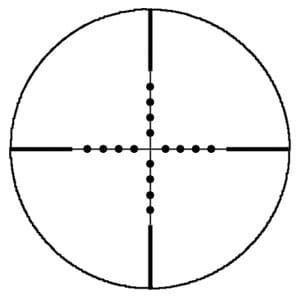 Everyone who has looked to purchase a scope has without a doubt run across the “mil”, “MOA”, and “milrad” abbreviations. I have a top-notch factory Remington 700 (XCR Tactical Long Range) that is just itching to be tested. The only problem was deciding on what glass to purchase. I eventually decided and placed my order with Brownell’s for a Trijicon Accupoint 5-20×50 before I changed my mind (keep an eye out for a gun and gear review). This scope has a 30mm tube, tritium and fiber-optic powered dot, and a standard mil-dot reticle. There it is – “mil-dot reticle”. I knew what a mil-dot is. Kind of…
Everyone who has looked to purchase a scope has without a doubt run across the “mil”, “MOA”, and “milrad” abbreviations. I have a top-notch factory Remington 700 (XCR Tactical Long Range) that is just itching to be tested. The only problem was deciding on what glass to purchase. I eventually decided and placed my order with Brownell’s for a Trijicon Accupoint 5-20×50 before I changed my mind (keep an eye out for a gun and gear review). This scope has a 30mm tube, tritium and fiber-optic powered dot, and a standard mil-dot reticle. There it is – “mil-dot reticle”. I knew what a mil-dot is. Kind of…
Boring background information…
I’ve read various posts online discussing “mils” and how to calculate distance to target by using an object of known (or close to) size. However, just knowing the formula and a term bothers me. Here’s some background info: For the record, there are two types of “mils”. The first is known as a military “mil” and is short for “angular mil”. The “mil” came into popularity during the 1950’s through a bunch of military proposals and discussions. The second “mil” that we see is commonly known as a milrad, and is an abbreviation for milliradian. They aren’t the same thing. But they kind of are. Read on.
An angular mil (i.e. a military mill) is defined as 1/6400th of a circle, where a milliradian turns out to be 1/6283rd of a circle (it is related to and is defined by π, hence the odd number). While they are technically different, as far as NATO and the U.S. military artillery teams are concerned, they are for all intents and purposes the same thing. The difference between an angular mil and a milrad translates to an approximate error of 1 yard at 1000 yards. When you’re dealing with artillery, one meter doesn’t make a huge difference. However, if you’re a Marine Sniper, you’ll probably disagree.
For a military sniper, being a meter off on a thousand meter shot probably translates into a miss. Luckily, almost every rifle scope, as well as most tank guns, pieces of stadiametric equipment and binoculars are calibrated in milliradians. From here on down in this article, a “mil” will refer to a milliradian since it is the most applicable. OK, back to the technical stuff…
Think way back to trigonometry and the term “radian” should stand out a bit. A radian is a trigonometric unit of measure, more specifically a unit of angular measurement. No need to run through your bookshelf to find an old textbook, I’ll try to explain what that means and how it relates to rifle scopes. At this point, just understand that it is a unit of measure.
While we’re discussing units of measure, did you ever wonder what the term “minutes” (or seconds) meant in the geological coordinate system? It doesn’t refer to a measure of time, unless you’re in a Concord Jet. A “minute” or “minute of angle (or arc)” is a way of making a degree more precise. Each degree can be broken down into sixty (60) minutes, and minutes can be further broken down into seconds (sixty as well).
Back to radians. A radian is described as the ratio between the length of an arc and its radius. Mathematically speaking, an angle of 1 radian results in an arc with a length equal to the radius of the circle. The image below is from Wikipedia and depicts what is meant above.
 Do you see a potential problem with this? Look closer, ah there it is! The arc is curve, which is not how we measure triangles, calculate holdover, etc. Luckily, the image above shows a fairly large triangle and over exaggerates what we are measuring. Remember, we are measuring in “milliradians”, that is 1/1000th of a radian. With milliradians, the angles are so small that sinθ=θ, meaning the trigonometric function of the angle is equal to the angle.
Do you see a potential problem with this? Look closer, ah there it is! The arc is curve, which is not how we measure triangles, calculate holdover, etc. Luckily, the image above shows a fairly large triangle and over exaggerates what we are measuring. Remember, we are measuring in “milliradians”, that is 1/1000th of a radian. With milliradians, the angles are so small that sinθ=θ, meaning the trigonometric function of the angle is equal to the angle.
Now the good stuff…
If you haven’t read it already, Nick put together a nice “Ask Foghorn” write-up on how to use the Mil-dot reticles in a scope to estimate range and how to calculate hold-over. The math isn’t really that confusing, but it introduces a potential error source.
Enter the “Mildot Master”. The Mildot Master is a slide-rule, which is nothing more than an analog calculator utilizing logarithmic and inverse logarithmic scales developed specifically for the following:
- Rapid and simple calculation of range to target, based on a measurement of the target with a mildot reticle, by aligning the estimated target size directly opposite the mildot measurement, and then reading the range at an index mark.
- Rapid and simple calculation of the amount of sight correction necessary to compensate for bullet drop and/or wind drift for a given range, enabling the shooter to determine either the equivalent telescopic sight adjustment (minute-of-angle, or MOA) or the equivalent hold-over (mils), by reading equivalents in both MOA and mils directly opposite the bullet drop/wind drift figure.
- Additionally, angle of fire for uphill or downhill shots can be accurately measured, and the up/down compensation can be closely calculated to reduce the errors such shots can induce
To run the “calculations”, you need to know the size of the target. Alternatively, you can also run the calculations if you know another reference measurement, such as a manmade object. Let’s run through an example. I stole the image below from Nick’s original write-up.
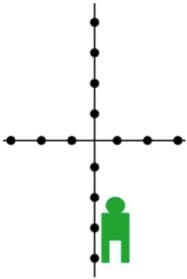 The little green man in the reticle measures 2.1 mils. If we use the same assumption that the average American male is 69.5”, we can run the “calculator”. A quick adjustment of the slide and we see that our target it around 900 yards away.
The little green man in the reticle measures 2.1 mils. If we use the same assumption that the average American male is 69.5”, we can run the “calculator”. A quick adjustment of the slide and we see that our target it around 900 yards away.
Easy as cake! Here is another example – a “non-human” this time. We know that the average whitetail buck is darn close to 18” from base of chest to top of spine. Using your reticle, you measure this space to be 1.5 mils.
 Grab the Mildot Master from your pocket and align 18” with the 1.5 Mil mark and read the distance indicated next to the “Target Range” marking. In this case, this buck is about 340 yards away. If you know the ballistics data of your particular load, the Mildot Master makes calculating drop, and thus holdover, quick and easy as well.
Grab the Mildot Master from your pocket and align 18” with the 1.5 Mil mark and read the distance indicated next to the “Target Range” marking. In this case, this buck is about 340 yards away. If you know the ballistics data of your particular load, the Mildot Master makes calculating drop, and thus holdover, quick and easy as well.
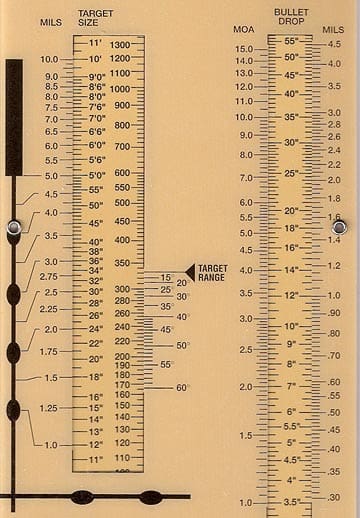 For my .308 Win with a 168-grain BTHP zeroed in at 100-yards, I know that the drop at 340-yards is right around 25”. With your Mildot Master slide held steady, a quick glance at the “Bullet Drop” chart on the right can help you with holdover. For 25”, the proper holdover in this case would be right around 2.1 mils. Does it get any easier?
For my .308 Win with a 168-grain BTHP zeroed in at 100-yards, I know that the drop at 340-yards is right around 25”. With your Mildot Master slide held steady, a quick glance at the “Bullet Drop” chart on the right can help you with holdover. For 25”, the proper holdover in this case would be right around 2.1 mils. Does it get any easier?
The Mildot Master includes a “blank” space on the back for you to cut and tape a copy of your ballistics data. They include in the owners manual a nice chart that you can photocopy and write in your data.
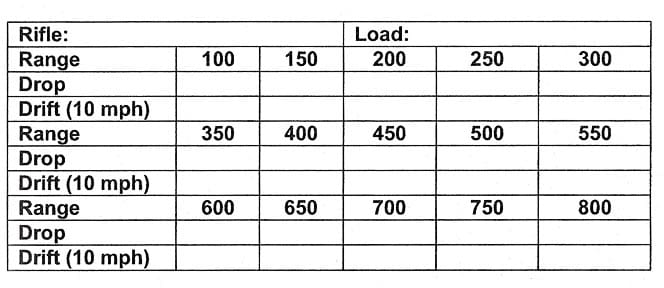 I made my own chart in MS Excel and I also taped in a copy of the mil-dot reticle dimensions. My chart is a bit “congested”, but only temprorarily. I found this data online, so I wanted to verify that it is accurate before I finalize my chart. I intend on making multiple charts with different zeros that I can laminate and then double-side tape into place.
I made my own chart in MS Excel and I also taped in a copy of the mil-dot reticle dimensions. My chart is a bit “congested”, but only temprorarily. I found this data online, so I wanted to verify that it is accurate before I finalize my chart. I intend on making multiple charts with different zeros that I can laminate and then double-side tape into place.
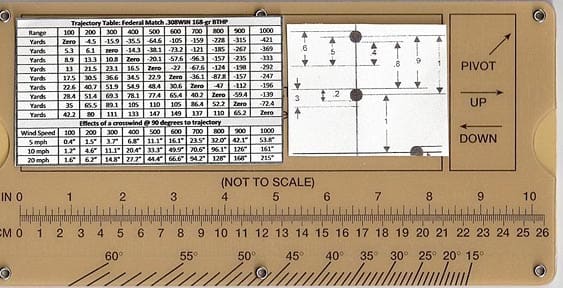 The Mildot Master is quick and easy to use. The included Instruction Manual includes tips, tricks, and ways of measuring and adjusting for shooting up/down hill. For less than $30, it is a great addition to any range, hunting, or tactical bag.
The Mildot Master is quick and easy to use. The included Instruction Manual includes tips, tricks, and ways of measuring and adjusting for shooting up/down hill. For less than $30, it is a great addition to any range, hunting, or tactical bag.
Ratings (Out of Five Stars)
All ratings are relative to other similar products. Overall rating is not mathematically derived from the constituent ratings.
Ergonomics: * * * * *
Easily fits in a hunting pack, side pocket, and even those “cheek piece” pads that have built-in pockets.
Ease of Use: * * * *
You need to know the size of the reference target – be it a human target or of the four-legged variety. You could also use other objects, such as fence posts, windows, tractor/car tires, or anything you feel you are confident you know the size of. This gets faster with practice and a little bit of mental training. Using a slide rule is so easy, an engineer can do it.
Overall Rating: * * * * *
The material is a heavy-duty laminate and will outlast any digital calculator that you can buy.
For More Information:
Browse the website and purchase directly from Mildot Master’s Website





Nifty tool. It’s nice to know the math so you know what it’s doing for you, but this is probably way faster.
One nitpick: “for all intensive purposes” should be “for all intents and purposes”.
Good call…
Sorry for my pedantry, but that’s a “slide chart” or or “Perrygraf”. It’s not a “slide rule”. Alas.
I guess you’re right – it’s more of a chart than a rule.
Sounds like a good idea for a smart phone app as well.
They have a few actually… I don’t know how I like that idea, although I do love my smartphones. I normally don’t leave my phone on while I’m hunting and the obvious weakness is having to rely on a battery. The few items that I don’t mind with batteries are GPS, or other items that take standard AA/AAA batteries. Proprietary batteries and chargers don’t fly with me for “in the field” use.
“Each degree can be broken down into sixty (60) degrees, and degrees can be further broken down into seconds (sixty as well).”
Should that read “Each degree can be broken down into sixty (60) minutes, and minutes can be broken down into seconds (sixty as well)”?
Correct – thanks for catching that!
Thanks, good refresher Haven’t used the Mildot Master for at least 5 years Enjoyed the challenge using hand guns, rifles and shot guns of picking target, guesstimating distance, squeeze the trigger and usually hitting the target.
We would set out plastic water bottles, steel plates and reactive targets(orange 4×4 cube, shot gun hulls) which were all picked up at end of session. Unfortunately there were a lot of slobs and tree shooters out there, we always had trash bags and picked up more trash than we came with. Not allowed to shoot in the boonies of eastern San Diego County on public land any more that I know of. Local range, Project 2000, has 100 yard indoor range, not much guesstimating going on at set distance. Did I mention using the Mildot Master, at least I feel a little better after some bitchin.
Anybody out there know of public land places to shoot in SD county ?
Good call on the post, I just got a 3-9×32 mildot scope for Chanukkah.
great article. always nice to see TTAG talk about GUNS instead of paranoid political droning.
I read the buck to be closer to 331-332 yards away in the picture of the scale rather than 340. In the grand scheme 8-10 yards isnt earth shattering, but am I missing something in how to read the scale?
Nice article; in particular, pictures of the dohickey being evaluated are much appreciated. Howsoever, in the interest of mathematical correctness, I feel moved to offer the following.
The article states that “the difference between an angular mil and a milrad translates to an approximate error of 1 yard at 1000 yards.” This is incorrect; instead, a milliradian (using the small angle approximation) by definition subtends 1 yard at 1000 yards. The “angular mil” is about 98.2% of the size of the milliradian so it is ever so slightly smaller. Therefore, while a milliradian subtends 1 yard at 1000 yards the angular mil will subtend just 35.34 inches. This is a difference of only .66 inches.
Thanks for the article – I don’t know if I need one of these things, but it sure looks nifty.
Comments are closed.